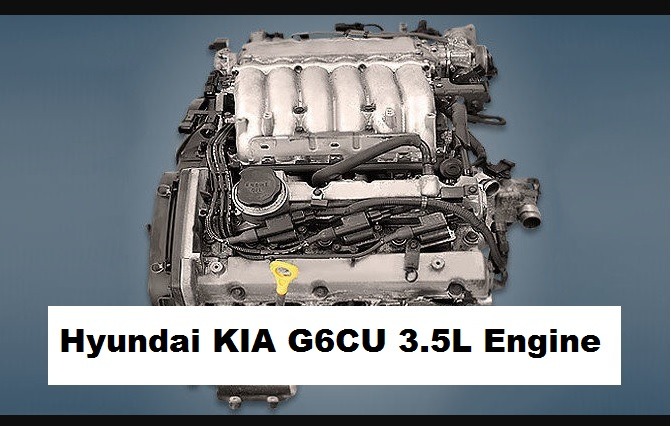Hyundai KIA G6CU 3.5L Engine Specs, Problems & Reliability
Hyundai KIA G6CU 3.5L Engine
Here in this post, I have gathered information about the Hyundai KIA G6CU 3.5L Engine from its official website, including its specifications, Problems, and Reliability.
We believe in providing reliable information to our readers, therefore we prefer to obtain information on the Hyundai KIA G6CU 3.5L Engine from authentic sources.
This article, which has been updated, has all the information you require about the Hyundai KIA G6CU 3.5L Engine.

Both the G6CU and the G6AU are 3.5D variants of the Sigma series’ V6 engine.
In the lineup of Hyundai and KIA midsize SUVs and minivans, these engines represent the top of the line.
These motors are comparable to Mitsubishi’s Pajero-specific 6G74 engine.
The cylinder block is made of cast iron, while the cylinder heads are made of aluminium and feature double overhead camshaft (DOHC) technology and four valves per cylinder.
The connecting rods are made of forged steel. Hydraulic lifters are used in the valve train.
There is no VVT system or other means of adjusting valve timing, and instead a timing belt powers the camshafts.
The intake manifold and fuel injectors in the engine are both made of cast aluminium, and the fuel injection system is electronic.
This is because the compression ratio is so low that normal fuel may be used.
| Production years | 1999-2007 |
| Displacement, cc | 3497 |
| Fuel system | distributed injection |
| Power output, hp | 195 – 220 |
| Torque output, Nm | 290 – 315 |
| Cylinder block | cast iron V6 |
| Blockhead | aluminium 24v |
| Cylinder bore, mm | 93 |
| Piston stroke, mm | 85.8 |
| Compression ratio | 10.0 |
| Hydraulic lifters | yes |
| Timing drive | belt |
| Turbocharging | no |
| Recommended engine oil | 5W-30, 5W-40 |
| Engine oil capacity, litre | 5.5 |
| Fuel type | 92 |
| Euro standards | EURO 3 |
| Fuel consumption, L/100 km (for Kia Sorento 2004) — City — highway — combined |
17.6 9.7 12.6 |
| Engine lifespan, km | ~350 000 |
| Weight, kg | 199 |
Hyundai KIA G6CU 3.5L Engine Specs, Problems & Reliability
The swirl flaps on the intake manifold are known to be a weak point of this engine. They loosen up quickly here, and then there are air leaks in the intake.
Finally, they come apart completely, and their bolts fall into the cylinders, causing damage there.
Since the oil burner is commonplace in this region, crankshaft liners regularly rotating is a sign of inadequate lubrication and a malfunctioning oil pump in this power unit.
For long distances, it’s best to use thick oil and change it often.
The crankshaft pulley is easy to spot because it has a few useful parts. Sensors often break, hydraulic lifters don’t do much, and they often start to knock after 100,000 kilometres of use.
The throttle, idle speed controller, or fuel injectors are dirty, so the engine speed keeps going up and down.
The main bearings are wearing out, the crankshaft is broken, and the cylinders and connecting rod bearings are also wearing out.
Most of the time, the engine knocks when it starts, but if the G6CU is badly damaged, it will beat all the time.
There are doubts about how well this engine will work.
After 45–60k miles, some of them were thrown away or had to have their cylinder blocks rebuilt.
Because important engine parts and pieces aren’t very good, the engine only lasts about 100,000 miles (bearings, oil rings, etc.).
If you want to rebuild your engine, you should order the Mitsubishi 6G74 OEM parts.
Hyundai KIA G6CU 3.5L Engine
Who makes Hyundai and Kia engines?
Since Hyundai Motor Company is Kia’s parent company, Hyundai makes the engines that Kia uses.
Throughout the world, Kia vehicles can be found powered by Hyundai engines made in Korea and China.
What year Hyundai had engine problems?
The present engine problems experienced by Hyundais and Kias can be traced back to the 2011 and 2012 Sonata models.
In May 2015, a group of consumers filed a class action lawsuit against Hyundai, claiming that the Sonata’s Theta engine was faulty.
What causes Kia engine failure?
The lawsuit says that the defect is caused by “an improper manufacturing and machining process,” which leads to the failure of the rotating assembly and, in turn, “prolonged failure of the connecting rod bearings in the engines as the crankshaft rotates within the connecting rod bearings and metal debris.”